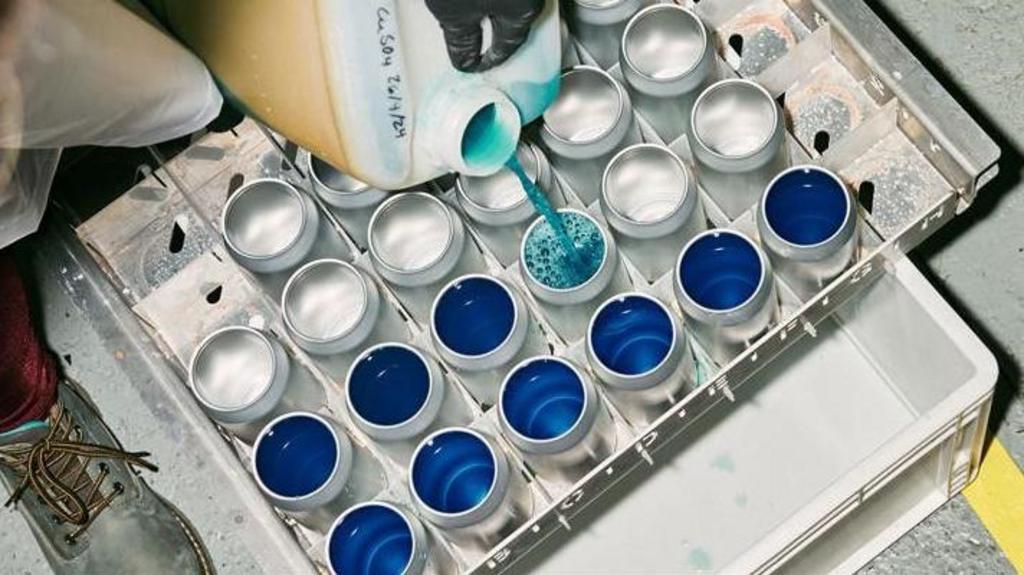Before me sits an array of aluminum cans, conspicuously devoid of beverages.
These cans are ingeniously designed to house an assortment of everyday products, from toiletries like shampoo and shower gel to condiments such as ketchup and household cleaning solutions.
I find myself at the London-based research and development center of Meadow, an innovative start-up pioneering a novel packaging system.
Meadow’s core concept involves transitioning products traditionally packaged in plastic to aluminum cans.
The company’s founders posit that this shift could mark a significant advancement in mitigating global plastic packaging waste, capitalizing on the superior recycling efficiency of aluminum cans relative to plastic – 81% versus 52%, as indicated by data from the National Packaging Waste Database.
Meadow has refined the standard aluminum beverage can to seamlessly integrate with a reusable canister, accommodating diverse dispensing mechanisms.
Depending on the product, the canister can be equipped with a pump, squeeze top, spray nozzle, screw-top lid, or other dispensing options.
The can itself features a tamper-evident sealed top and strategically placed crimples to prevent accidental consumption.
Once emptied, the can can be easily removed for recycling and replaced with a fresh unit.
Aluminum can manufacturer Ball, which already offers recyclable aluminum packaging for shampoos and lotions, has invested in Meadow and will offer the system to the big personal care brands it works with.
“We realized the greenest container already exists – the aluminium can. So we thought, what do we need to do, to take it to new industries?” says Victor Ljungberg, Meadow’s co-founder and chief executive, who is based in Stockholm, Sweden.
Aluminum possesses robust recyclability attributes, widely regarded as infinitely recyclable, a stark contrast to plastic, which degrades in quality after multiple recycling cycles.
Furthermore, aluminum is lighter than glass, resulting in reduced energy consumption during transportation.
The wine industry has already experimented with full-sized aluminum bottles, with organic brand Vinca launching them in March via Tesco. Aldi also introduced its own-label wine in aluminum bottles this year.
As new EU packaging and waste regulations take effect in January 2030, mandating that all packaging be at least 70% recyclable, with a target of 80% by 2038, more sectors are poised to embrace this shift.
However, challenges remain.
The production of virgin aluminum is energy-intensive, requiring nearly double the energy compared to glass manufacturing.
Assessing the overall environmental footprint of aluminum versus glass is a complex undertaking, often contingent on the specific application and transportation considerations.
Price is a key determinant, according to Mark Lansley, CEO of Broadland Drinks, the supplier of aluminum-bottled wine to Aldi, with plans for another launch this year.
Mr. Lansley notes that while aluminum is a third lighter than glass, reducing CO2 emissions by roughly 900 grams, it is also four times more expensive.
He acknowledges absorbing the added cost alongside Aldi to foster innovation but emphasizes that widespread adoption hinges on cost reduction.
“We’ve got to get over this cost. We’ve got to sell the benefits and better spell out the lower carbon footprint that aluminium has,” says Mr Lansley.
Consumer acceptance of alternative packaging aesthetics is also critical.
Mr. Lansley points out that the wine industry navigated this hurdle with the introduction of screw tops, but certain occasions still demand a traditional glass bottle.
“Aluminium bottles are lighter and don’t shatter, so they are much better for a picnic, or by the pool. But then you’ve got tradition, and what folks are used to.
“You might be opening a bottle of wine to celebrate with friends, or as a reward and relaxation. A glass bottle of wine is embedded in that culture,” says Mr Lansley.
Jamie Stone, a packaging expert at PA Consulting, highlights that consumers’ associations with favorite brands are deliberately cultivated, making a shift potentially challenging.
“Big brands have spent decades and invested billions in educating customers on distinctive packaging – think of the iconic Heinz ketchup bottle, a bottle of Flash spray, or Kikkoman soy sauce,” Mr Stone, who is London-based, points out.
“Aluminium can’t easily make shaped packs. That’s a challenge when shape forms a key part of brand identity and consumer recognition. Think how many everyday products – like sauces, shampoo, washing up liquid, or moisturisers – rely on squeezable packaging. Aluminium, being rigid, removes that functionality.”
He adds: “In many categories, consumers want to see the product they’re buying, whether it’s the colour of a juice, the consistency of a lotion, or the thickness of a sauce. Aluminium’s opacity removes that visual connection.”
Mark Armstrong, design director at creative agency Marks, notes that manufacturers’ established plastic packaging lines, requiring costly modifications or replacements for aluminum, have hindered its widespread adoption.
Furthermore, most food-grade aluminum necessitates internal lacquer or polymer coatings that comply with recyclability standards, Mr. Armstrong adds.
“Aluminium is arguably the champion of recyclable materials. But the options for dispensing and reseal-ability often rely on a secondary plastic material. This then compromises the recyclability for consumers if it requires them to separate out materials to be recycled, which greatly weakens the appeal,” says Mr Armstrong.
Advances in sustainable plastics, including infinitely recyclable and biodegradable options, also pose competition.
Jayne Paramor, sustainable packaging lead at Anthesis, suggests that plastic may remain the preferred choice for brands.
“Plastics remain highly suited to many packaging applications due to their durability, inertness and design flexibility,” says Ms Paramor.

